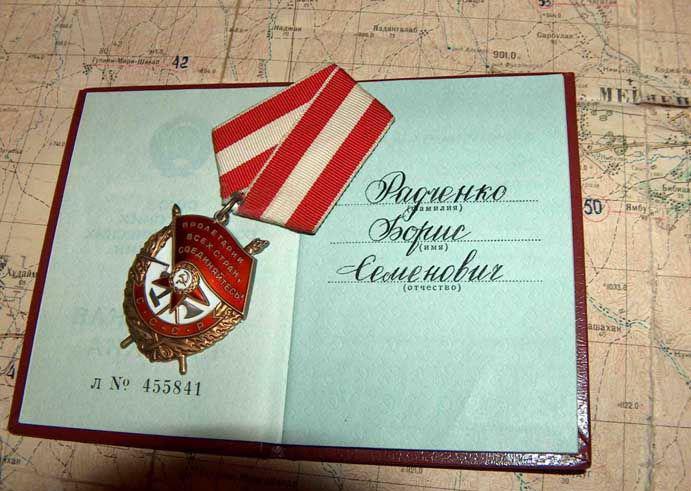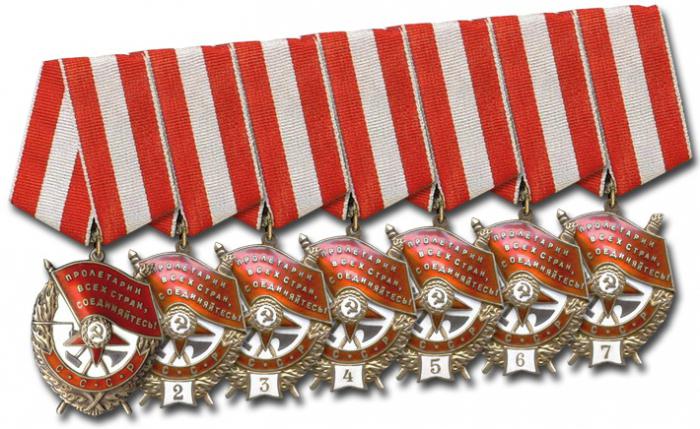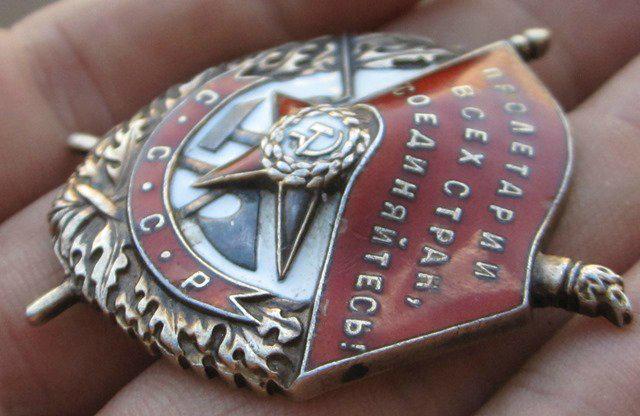The Red Banner Orders are the first awards of the Soviet state. They were established to be rewarded for manifestations of special courage, dedication and courage in the defense of the Fatherland. In addition, military units, ships, public and state organizations were awarded the Order of the Red Banner. Until 1930, the order was the highest degree of encouragement in the Soviet Union.
First Soviet Award
In 1918, a few days before the celebration of the first anniversary of the October Socialist Revolution, the first badge, the Order of the Red Banner, was approved in the country of Soviets. There was this award in two versions: Combat and Labor. In September 1918, the statute of this sign was first approved, and then, a month later, he himself appeared.
A bit of history
It is a well-known fact that the Bolsheviks, having come to power in 1917, canceled all the awards and insignia that existed in the pre-revolutionary period of the history of our country. Initially, all the promotions that celebrated any merits to the Motherland were replaced by personalized gifts: cigarette cases, watches, and weapons. However, the longer the civil war in Russia lasted, the clearer the need for the appearance of badges that would clearly demonstrate the merits of a person to a new country and a new government. Thus, they would encourage even more selfless activity of those who have already received such encouragement, and those who only aspired to it.

As a result, in 1918, at the initiative of Sverdlov, Y. M. the All-Russian Central Executive Committee created a special commission that began to develop a draft of the first award insignia in the country for fighters and commanders of the Red Army. This group is headed by Avel Safronovich Yenukidze, and the work on the sketch of the order is entrusted to the artist Denisov V.I. and his son Denisov V.V. So, literally after a few days of hard work, father and son offer sketches of the first Soviet badge for consideration by the commission. Of several options, we chose the one that included all the elements symbolizing the young Soviet power. This is a red star, a developing red banner, a sickle and a hammer, a plow and a bayonet, which are symbols of the union of peasants, workers and soldiers. The final design sketch was approved in October 1918 by the Presidium of the All-Russian Central Executive Committee. Thus, by issuing orders of the Labor and Combat Red Banner, the young state celebrated the first anniversary of the Great October Revolution.

Award Statute
The statute for the orders of the Battle and Labor Red Banner was very short. It contained a little specificity about what actions a person can be noted with this award. This is explained by the fact that the “Red Banners” were the only honorary characters of their kind and in the system of the young state in principle. In particular, this was mentioned in a special explanation. The Order of the Fighting Red Banner was the only encouragement that could be awarded to the soldiers of the Red Army for their military merits. He was noted for courage, special courage and selflessness as individuals and military units (companies, regiments, units, etc.), and public organizations. Cavaliers awarded the Order of the Red Banner were called the "Red Banner", and collectives - the "Red Banner". Subsequently, the statute of this badge was edited and supplemented several times.
All the first "Red Banners" were supplemented with special certificates in which it was said to whom, when and for what merits this award was presented. Such a letter was a very important and necessary attribute, certifying the right to be encouraged to wear such a sign. According to the original statute, only commissars and commanders of the Red Army, volunteer detachments, and navy had the right to submit to the order. However, over time, the list of promising gentlemen was expanded.
Award Description
Badges "Red Banners" were made of silver in the form of a laurel wreath (gilded), acting as its basis. In the lower part there was a ribbon on which was written in gold letters "USSR". The top of the order was covered by a detailed red banner, on which was written "Workers of all countries, unite!" Slightly below the center, the flag pole crosses the torch. Their lower ends protrude slightly beyond the wreath. The flame of the torch on the order should symbolize the immortal feat of the heroes of the revolution. In the center of the icon on a white background are crossed hammers, a plow and a bayonet that are covered by a five-pointed inverted red star. At its center is a golden laurel wreath, inside of which a gilded sickle and hammer are placed on a white field.
On repeated orders of the Red Banner, a small white enamel shield was placed directly under the ribbon, the numbers 2, 3, 4 and so on were placed on it. They mean the number of awards with this sign. The banner, ribbon and ends of the five-pointed star are covered with ruby red enamel, and the images of the hammer and plow are oxidized, the remaining images and inscriptions are gilded.
Parameters
The Order of the Red Banner of Labor, like its combat version, was made of silver. Its content in this award is 22.719 grams ± 1.389. The total weight of the mark is 25.134 grams ± 1.8. The height of the order is 41 mm, the width is 36.3 mm. With the help of a ring and an eyelet, the award is connected to a rectangular block, which is covered with a moire silk ribbon, 24 mm wide. At its center is a white longitudinal strip, the width of which is eight millimeters, closer to the edges are two more white stripes seven millimeters wide each and two white stripes one millimeter wide. Cavaliers of this order wear it on the left side of the chest.
First cavalier
The first owner of this honorary award was Blucher Vasily Konstantinovich, in 1918 he was chairman of the Chelyabinsk Revolutionary Committee. He received the Order of the Fighting Red Banner for the fact that he managed to unite several armed detachments under his command, with which he made his legendary campaign to the Urals. This military operation was accompanied by fierce and heavy fighting with White Guard detachments. Headed by Blucher, a ten-thousand-strong army marched through enemy rear lines and overcame 1,500 kilometers in forty days, after which the partisans connected with regular Soviet units. For the achievement of this feat on September 30, 1918, the All-Russian Central Executive Committee represents Blucher for the government award - the Order of the Red Banner at the first number. Subsequently, for the entire period of the Civil War, he was presented three more times for this honorary award. And his fifth Order of the Red Banner Vasily Blucher receives for his work in China, where he was a military adviser to the revolutionary government. However, it is worth noting that all these merits did not save the Soviet marshal from repression and death.

The Great Patriotic War
During the Second World War, the “Red Banner of Victory” (as the soldiers of the Red Army nicknamed the order) was awarded 305035 times. Many warriors have earned several of these awards at once. It is worth thinking about this figure - more than three hundred thousand, and despite the fact that such a sign was among the elite. Such a quantity speaks without any words of a high degree of heroism and self-sacrifice shown by Russian soldiers. Usually the "Red Banner of Victory" was received by the commanders of various formations, as well as pilots for successfully conducted assault / bombing, downed enemy vehicles. The junior commanders of the Red Army, and especially the rank and file and sergeant formations, received this honor extremely rarely.
Exceptions to the Rules
However, unique cases have been recorded. For example, the young partisan Volodya Dubinin was awarded this sign at the age of 13, though posthumously; and 14-year-old Igor Pakhomov had two orders at once. Another Kiev schoolchild at the age of 12 received this award for having kept two regimental banners during the occupation.
Complete Award List
In total, from 1918 to 1991, this award was issued more than 580 thousand times, including the Order of the Red Banner of Labor. Moreover, some individuals became fivefold, sixfold, and some became sevenfold cavaliers. The first who was able to receive the order with the number seven on the front side in 1967 was Major General Aviation M.I. Burtsev. Later, another renowned pilot ace, aviation marshal I.N. Kozhedub became another seven-time holder of this badge. Today, this government award has been abolished, but the most illustrious units and formations of the armed forces continue to be called the Red Banner.